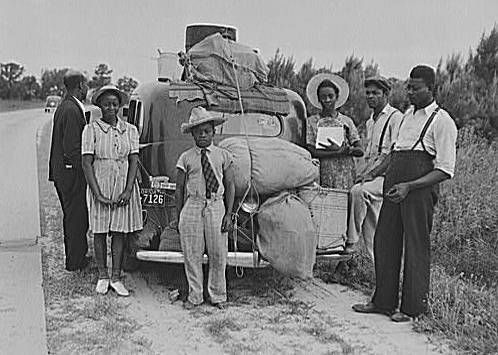#WaterYear 261
Today is Juneteenth & June is Black Music Month. As the Smithsonian @si_africanart podcast says: "All music is Black music" - & that is certainly true of rock.
A 🧵on the Black music roots of rock - and the role of a river flood
@rockhall on L. Erie in CLE, OH
Today is Juneteenth & June is Black Music Month. As the Smithsonian @si_africanart podcast says: "All music is Black music" - & that is certainly true of rock.
A 🧵on the Black music roots of rock - and the role of a river flood
@rockhall on L. Erie in CLE, OH

2/ When the Levees Broke: the flood that made rock and roll.
In 1927, an epic flood on the Mississippi River killed hundreds & wreaked massive property damage. But in its wake of destruction, that flood created rock ‘n’ roll.
(🧵adapted from this essay) grist.org/article/2011-0…
In 1927, an epic flood on the Mississippi River killed hundreds & wreaked massive property damage. But in its wake of destruction, that flood created rock ‘n’ roll.
(🧵adapted from this essay) grist.org/article/2011-0…
3/ To be fair, rock ‘n’ roll, like the Mississippi, is a seriously big river, one with many tributaries that converged to form its still-shifting channel. But one of its tributaries — and perhaps the essential one, with a gritty, longing, shuffling beat... 

4/ ...still pulsing unmistakably within the bigger river — sprang forth from the black mud that covered the whole Mississippi Delta when the swollen river finally slunk back to its banks in the late summer of 1927. 

5/ The flood reexposed the deep racial fissures that the Delta society had worked hard to either smooth over or wish away. In the wake of the ugliness and economic upheaval, a river of rural Black people began moving north from the Delta. 

6/ Delta blues musicians chronicled the flood & its aftermath. Consider “When the Levee Breaks,” by Kansas Joe McCoy & Memphis Minnie. Over a traditional Delta Blues riff on acoustic guitar, McCoy tells how Black people were forced to work during the flood open.spotify.com/track/4QnSKHUl…
7/..to save the levees in, working conditions not that different from the slavery period:
“I works on the levee, mama both night and day, I works so hard, to keep the water away.”
With the final line, he alludes to the great migration of Black people moving northward:
“I works on the levee, mama both night and day, I works so hard, to keep the water away.”
With the final line, he alludes to the great migration of Black people moving northward:

8/
“I’s a mean old levee, cause me to weep and moan, gonna leave my baby, and my happy home.”
Led Zeppelin recorded a cover of the song and added greater geographic specificity to that final line...
“I’s a mean old levee, cause me to weep and moan, gonna leave my baby, and my happy home.”
Led Zeppelin recorded a cover of the song and added greater geographic specificity to that final line...

9/ In so doing, they revealed the city where the Delta blues were transformed, the setting for the alchemy that gave their version such heft:
“...going, going to Chicago.”
Chicago was the destination for many of the Delta migrants and..
open.spotify.com/track/05f8Hg3R…
“...going, going to Chicago.”
Chicago was the destination for many of the Delta migrants and..
open.spotify.com/track/05f8Hg3R…
10/...in Chicago, the Delta Blues got plugged into amps and electrified. There, Chess Records artists, like Howlin’ Wolf, Muddy Waters, and John Lee Hooker, provided the first DNA strands that mutated and gloriously evolved the Delta Blues into “Chicago Blues.” 

11/ With the vigor of a new species, the Chicago Blues dispersed globally and, where they touched down, continued to evolve. In London, Keith Richards and Mick Jagger bonded over their mail-order records from Chess. 

12/ As I said before, rock ‘n’ roll sprang from many sources. But stripped to its essence, its true heart may be the primal beat & yearning soul of the electrified Delta Blues. The northward migration of Black people from Mississippi Delta to Chicago...
open.spotify.com/track/6uSBSTEn…
open.spotify.com/track/6uSBSTEn…

13/...set this electro-evolution in motion, and that migration was amplified by the great flood of 1927.
And although rock has continued to evolve, you can still hear the black Delta mud in its DNA.
(Black Mud from @theblackkeys):
open.spotify.com/track/2y42MmBC…
And although rock has continued to evolve, you can still hear the black Delta mud in its DNA.
(Black Mud from @theblackkeys):
open.spotify.com/track/2y42MmBC…
14/
Podcast of the Smithsonian National Museum of African American History and Culture: All Music is Black Music @si_africanart
nmaahc.si.edu/explore/initia….
Podcast of the Smithsonian National Museum of African American History and Culture: All Music is Black Music @si_africanart
nmaahc.si.edu/explore/initia….
15/ "Musical Crossroads" from @si_africanart which tells the story of African American music from the arrival of the first Africans to the present day.
nmaahc.si.edu/explore/exhibi…
nmaahc.si.edu/explore/exhibi…
@threadreaderapp unroll
• • •
Missing some Tweet in this thread? You can try to
force a refresh

 Read on Twitter
Read on Twitter










